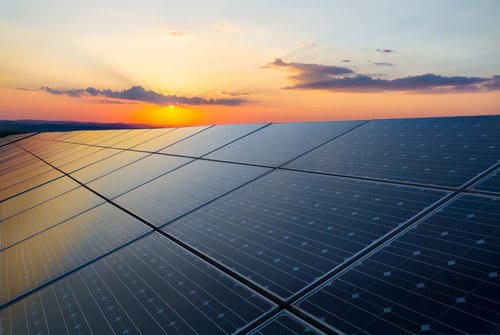
The solar revolution is upon us, and yet many still don’t get it. Yes, they say, solar will play an increasing role in the world’s energy systems, but they still fail to comprehend to what extent solar will become the dominant energy provider in the decades to come.
This is true even of the International Energy Agency, which nevertheless concedes that solar will become the biggest individual source of power by 2050. It is true of Bill Gates, who is still searching for an energy miracle when there is one right in front of him. And it is certainly true of the fossil fuel industry which, having given up fighting for its future on environmental grounds, still wants to believe that coal is the key to unlocking “energy poverty”.
Last week’s Future of Energy conference in New York, hosted by Bloomberg New Energy Finance, included some fascinating insight into just how quick this transition to solar is happening. Here are a bunch of graphs to illustrate.
The first is from Jon Moore, the BNEF chief, who predicts that more than two-thirds of all new energy generation capacity around the world in the next 25 years will come from renewables, notwithstanding the huge growth in energy demand from emerging economies.
Solar, Moore says, will account for one-third of all new capacity – 3.43 terrawatts, or 3.43 million megawatts – a ten-fold increase on today’s capacity. It will be spread evenly between utility scale solar and “distributed solar”, much of the latter being installed behind the meter and on the rooftops of houses, businesses and factories.
The solar capacity will match the combined new capacity of coal, gas and nuclear – almost all of a which will be built in the developing world. Wind, hydro and other renewables make up the remainder.
This next graph from Michael Liebreich, the former BNEF chief and now chair of its advisory panel, illustrates how the major energy bodies have and continue to be caught offside by this growth.
It is a similar graph to the famous one that showed how only Greenpeace successfully predicted the growth of solar over the past decade. The IEA, over the past 15 years, has increased its solar forecasts 14-fold, but is still short of the BNEF target by a factor of more than three. (Liebreich’s numbers for 2040 include installed capacity).
Indeed, Liebreich pointed to the recent solar auction in Mexico, where the lowest bid came in at a record $US36/MWh, including renewable energy certificates, as a sign solar costs continue to fall dramatically, and unexpectedly.
Liebreich also used this graph below to ridicule the recent comments by Microsoft founder Bill Gates, who has called for an “energy miracle” to solve electricity supply and greenhouse emissions issues.
“We’ve seen the costs (of solar) come down by a factor of 150 since 1975,” Liebreich said. “We’ve seen volume up by 115,000. How much more miracle-y do you need your miracles to be?”
Gates, like the fossil fuel industry, throws the spotlight on “energy poverty” in third world countries. The coal industry, for instance, says that to deprive developing countries of fossil fuels is to deprive them of access to energy.
Forget for the moment that fossil fuels, in most developing countries, are heavily subsidised and still can’t be built cheaply enough to reach much of the population.
Liebreich says that a solar lamp costing $2 can bring light to developing areas. “The entire population of children studying by candlelight could be given those lamps for a cost of just over $1 billion dollars, or more to the point that families could, perhaps, buy them for two dollars each.”
As this graph above shows, BNEF estimates that 100 million households in off-grid areas will have solar by 2020 – not just tiny lanterns, but also larger solar installations that can power many more appliances. That is a lot more accessible than a new grid built to support centralised fossil fuels. But don’t expect the fossil fuel industry to admit that any time soon.














